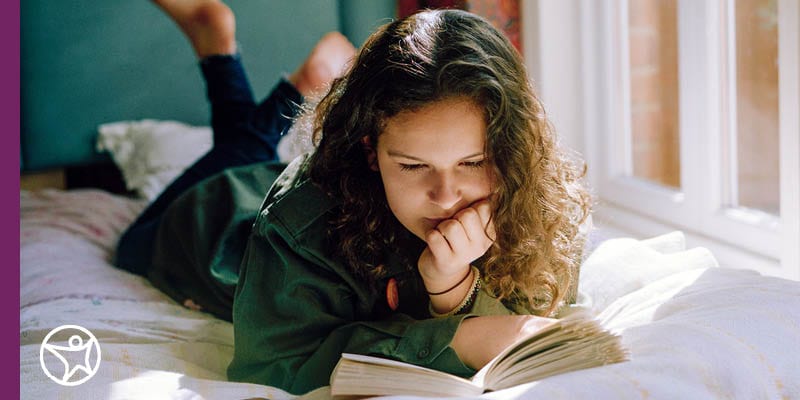Surprising Ways Creative Writing Can Help Your Child Learn
byJulie Hersum
6 min to read
While essays are the most common writing practice students get in school, creative writing can help students go beyond sentence structure and grammar to explore the world, stretch their imaginations, and even discover more about themselves.
What Is Creative Writing?
Creative writing is a form of artistic expression where the writer uses their imagination to communicate meaning, ideas, and emotion through fictional stories, personal essays, memoirs, poems, song lyrics, comics, graphic novels, and even scripts for stage or screen.
Because there are so many forms of creative writing, it’s easy for students to find one that excites them and encourages their unique voice.
Beyond putting words on paper, creative writing involves students studying writing elements like voice, character, point of view, and setting while experimenting with their own ideas and style.
Students can craft their own creative stories or read other creative writing to explore different perspectives, learn different storytelling techniques, and explore worlds, cultures, and time periods they otherwise wouldn’t. This helps build writing skills, and critical thinking.
Benefits of Creative Writing for Kids
Boosts Confidence and Self-Expression
One of the most empowering aspects of creative writing is that it gives students the freedom to express their thoughts and feelings without fearing “wrong” answers.
Whether they’re creating a fantasy world or journaling about their day, writing encourages self-reflection and self-confidence—key ingredients for both academic success and personal growth.
Strengthens Reading and Writing Skills
Creative writing can help students develop their linguistic intelligence. Students with high linguistic intelligence tend to enjoy learning new vocabulary, telling stories, learning new languages, reading, and writing.
When students write creatively, they can have fun while learning to choose their words, playing with sentence structure, experimenting with grammar—learning when and how to break grammatical rules for stylistic effects.
Writing can help students become stronger readers too as they start to notice how other authors of their favorite books build characters, settings, tension, dialogue, action, and dramatic effects.
Fosters Creative and Critical Thinking
Whether crafting a poem or inventing a plot twist in a short story, creative writing encourages students to think outside the box. Through writing, they can learn how to structure stories, create conflict, and imagine solutions—skills that will prove valuable in every subject and throughout their lives.
Improves Problem-Solving Skills
Additionally, creative writing encourages students to be resilient, imaginative problem solvers and creative thinkers, since most stories should have a problem that must be solved or a conflict that must be resolved.
Students can be as realistic or outlandish as they want in how the stories’ problems are solved, because the solutions are not necessarily bound by this world’s rules (although they can be if the student chooses).
Creative Writing Ideas for Kids
While short stories are a great start, there are other ways students can creatively write. Here are five creative writing ideas for kids.
Journaling
Journaling is a simple yet powerful creative writing activity that’s also self-reflective—an opportunity for kids to explore their emotions and experiences in a safe, judgment-free way. When students write freely in a journal, they learn to express themselves with clarity and honesty—all while strengthening their writing voice.
Journaling can be guided by prompts or left completely open-ended, allowing students to reflect on personal experiences, observations, or creative ideas.
Because there are no strict grammar rules or formal structures to follow, journaling helps young writers develop confidence while building self-awareness and emotional literacy.
Find some journaling prompts for students here.
Poetry
Poetry invites kids to play with language, imagery, and rhythm while encouraging them to think deeply about meaning and emotion. From short and structured forms like haiku to free verse and rhyming couplets, poetry gives students endless room for creative experimentation.
Writing poems helps kids expand their vocabulary, improve their descriptive writing, and sharpen their ability to express complex feelings in just a few carefully chosen words. It’s also an excellent format for students to play with structure and words. For example, haiku is an understandable form of poetry for young students to read and imitate.
Learning Coaches may consider having more academically advanced students read classic poems, analyze them both in terms of their meanings and uses of language, and write their own poems in similar structures.
Song Lyrics
Whether kids write new lyrics for a favorite tune or craft original words for their own melody, this exercise helps them experiment with rhythm, word choice, and tone. Writing lyrics also encourages students to translate feelings or stories into language that flows, sharpening both their vocabulary and their ability to communicate emotions. Plus, when students set their lyrics to music or share them aloud, it can help build confidence when they see how powerful their words can be.
Try asking your student to create new lyrics to one of their favorite songs or even a classic nursery rhyme.
Comics or Graphic Novels
Illustrated narratives like comics and graphic novels are a fantastic way for kids to blend visual creativity with written storytelling. This style of writing helps students practice crafting dialogue, organizing story structure, and expressing ideas concisely, since text space is often limited.
Illustrated narratives also encourage young writers to think about how words and images work together to create meaning. For students who feel intimidated by long writing assignments, this format can be especially inviting and can offer a playful, artistic path to strengthen both their writing and their storytelling confidence.
Have your student create their own illustrated narratives by drawing a comic complete with dialog bubbles that speak to a given prompt. The prompt can be something simple like, “How did your morning routine go?” or something more fun, like, “What would your pet say and do if they were a superhero?”
Scriptwriting
Scriptwriting, or screenwriting, is a fun and imaginative way for students to turn ideas into dialogue-driven stories meant for the stage or screen.
Because scripts focus on what characters say and do rather than long descriptions, students learn to use powerful verbs and to be more precise, descriptive, and purposeful writers.
Have your student try screenwriting by rewriting the ending to a movie they’ve watched or create something original. Either way, scriptwriting gives students a hands-on way to sharpen their creativity and storytelling confidence.
Why Creative Writing Is Important
Creative writing isn’t just for the classroom—it’s a tool for lifelong learning. Whether your child dreams of becoming an author or simply enjoys storytelling, writing creatively can help them develop skills that translate to many areas of life: communication, problem-solving, and resilience.
Creative writing nurtures both academic growth and personal development, helping students turn into better thinkers, communicators, and creators. Many schools and libraries even offer creative writing classes or clubs like Connection’s Academy’s Writer’s Oasis Club. Creative Writing clubs can make writing social as students gain confidence in sharing their voice with the world.



